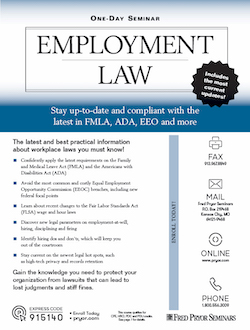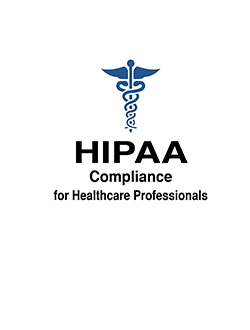DOLs Final Rule for Overtime Exemption: The Duties Test (Video)
- Author: Lisa Smith
- Categories:
- Tags:
- Share on:
Do you know and understand the overtime exemption rule recently released by the Department of Labor? In this video, Lisa Smith gives an overview of which duties qualify an individual for exemption.
Transcript
Under the final rule that was issued May 18 of 2016, we know that the duties tests were not changed. So that is significant, because, basically, what we have to look at now is are we paying our exempt worker at least $913 every week of the year that they perform work and do they meet the duties test that is currently in place and has been in place for several years.
So what are the duties? Well, in a nutshell, the duties are that the employee may not perform blue collar type work more than half the time. Now, that is a very broad statement, because the broad statement of half the time could really be misinterpreted.
A good rule of thumb is actually maybe a 70% rule. So 70% administrative work that is exempt, and maybe 30% non-exempt work. Because the Department of Labor is realistic. Everybody knows that exempt workers do perform non-exempt duties at times, and that’s OK. It’s to be expected.
However, it’s only when that non-exempt set of duties ends up infringing and taking over. Now, we may have an exemption that’s been broken, and we may owe that worker over time. So the duties that are currently in place are very, very important to take a look at and to audit internally.
So you need to make a decision. Number one, can you afford to pay $913 a week? And if the answer is yes, or if the answer is I’m already paying more than that, well, then good job.
Now, let’s look at the duties and make sure that the duties actually qualify for the exempt status. Along with the minimal blue collar non-exempt type work, we also want to consider how much independent decision making and discretion over matters of significance in your organization that each exempt worker actually touches.
So when we’re looking at the exemption, let’s ask ourself that big question. Is there fluidity? Do they have abilities to possibly make changes in the organization? Not that they have to have the final say so, but do they affect matters of significance in your organization?
There are many other items to consider, and we will be talking about these in future broadcasts.
Please always remember, you can’t be audit proof, but you can be audit secure.
Come on back. We’re going to continue to talk about how you can audit secure your business.
DISCLAIMER:
Purchasers, readers, or users of this blog post agree to be bound by the following terms: Information contained in this blog post has been obtained by Pryor Learning Solutions from sources believed to be reliable. The subject is constantly evolving, and the information provided is not exhaustive. The advice and strategies contained should not be used as a substitute for consulting with a qualified professional where professional assistance is required or appropriate, or where there may be any risk to health or property. In no event will Pryor Learning Solutions or any of its respective affiliates, distributors, employees, agents, content contributors, or licensors be liable or responsible for damages including direct, indirect, special, consequential, incidental, punitive, exemplary losses, or damages and expenses including business interruption, loss of profits, lost business, or lost savings. For purposes of illustrating concepts and techniques described in this course, the author has created fictitious names; mailing, e-mail, and internet addresses; phone numbers and fax numbers; and similar information. Any resemblance of this fictitious data that is similar to an actual person or organization is unintentional and purely coincidental.
Choose a Seminar and Save $10
Sexual Harassment & Bullying in the Workplace
1 Day
- CEU: 0.6
- CPE: 6
Team Training - Virtual or In-person

Comprehensive Training for HR Managers (2-Day)
2 Days
- CEU: 1.2
- CPE: 12
- HRCI: 11
- PDC: 12
Virtual Seminars:
-
Apr 7-8
-
Apr 9-10
-
Apr 15-16
-
+ 23 more dates

Human Resources for Anyone with Newly Assigned HR Responsibilities
1 Day
- CEU: 0.6
- CPE: 6
- HRCI: 5.5
- PDC: 6
Virtual Seminars:
-
Apr 7
-
Apr 8
-
Apr 16
-
+ 35 more dates

Training the Trainer
1 Day
- CEU: 0.6
- CPE: 6
Virtual Seminars:
-
Apr 8
-
Apr 16
-
Apr 18
-
+ 17 more dates

Payroll Law
1 Day
- CEU: 0.6
- CPE: 6
- HRCI: 5.5
- PDC: 6
Virtual Seminars:
-
Apr 8
-
Apr 9
-
Apr 14
-
+ 29 more dates
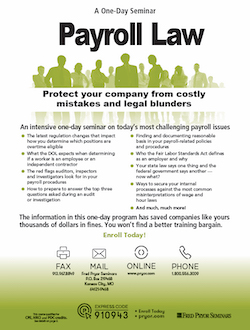
Workers' Comp
1 Day
- CEU: 0.6
- CPE: 6
- HRCI: 5.5
- PDC: 6
Virtual Seminars:
-
Apr 10
-
Apr 15
-
Apr 23
-
+ 5 more dates

The Essentials of HR Law
1 Day
- CEU: 0.6
- CPE: 6
- HRCI: 5.5
- PDC: 6
Virtual Seminars:
-
Apr 11
-
Apr 14
-
Apr 16
-
+ 27 more dates
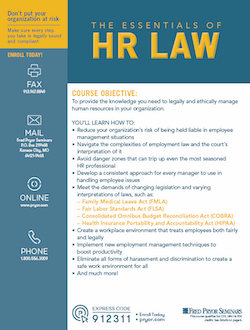
FMLA Compliance
1 Day
- CEU: 0.6
- CPE: 6
- HRCI: 5.5
- PDC: 6
Virtual Seminars:
-
Apr 17
-
Apr 28
-
May 7
-
+ 15 more dates
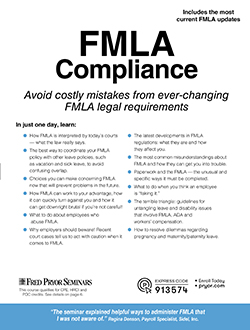
Learn to Write Effective Policies & Procedures
1 Day
- CEU: 0.6
- CPE: 6
Virtual Seminars:
-
May 5
-
May 16
-
May 22
-
+ 5 more dates




